标签:man 基本 tee inline lock package lua geo nal
导入numpy库,并查看numpy版本
import numpy as np
np.__version__'1.13.0'import matplotlib.pyplot as pltcat = plt.imread('cat.jpg')print(cat)[[[231 186 131]
[232 187 132]
[233 188 133]
...,
[100 54 54]
[ 92 48 47]
[ 85 43 44]]
[[232 187 132]
[232 187 132]
[233 188 133]
...,
[100 54 54]
[ 92 48 47]
[ 84 42 43]]
[[232 187 132]
[233 188 133]
[233 188 133]
...,
[ 99 53 53]
[ 91 47 46]
[ 83 41 42]]
...,
[[199 119 82]
[199 119 82]
[200 120 83]
...,
[189 99 65]
[187 97 63]
[187 97 63]]
[[199 119 82]
[199 119 82]
[199 119 82]
...,
[188 98 64]
[186 96 62]
[188 95 62]]
[[199 119 82]
[199 119 82]
[199 119 82]
...,
[188 98 64]
[188 95 62]
[188 95 62]]]type(cat)numpy.ndarraycat.shape(456, 730, 3)plt.imshow(cat)
plt.show()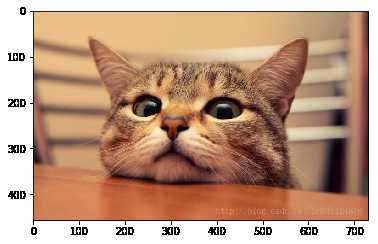
#请问电影是什么,nd.array 四维
#(x,456,760,3)参数为列表:
[1, 4, 2, 5, 3]
注意:
l = [3,1,4,5,9,6]
n = np.array(l)display(n,l)array([3, 1, 4, 5, 9, 6])[3, 1, 4, 5, 9, 6]display(n.shape,l.shape)--------------------------------------------------------------
AttributeError Traceback (most recent call last)
<ipython-input-15-5eeacc6c47ae> in <module>()
----> 1 display(n.shape,l.shape)AttributeError: 'list' object has no attribute 'shape'n2 = np.array([[3,4,7,1],[3,0,1,8],[2,4,6,8]])
display(n2.shape)(3, 4)n3 = np.array(['0',9.18,20])
n3array(['0', '9.18', '20'],
dtype='<U4')n4 = np.array([1,2,3.14])
n4array([ 1. , 2. , 3.14])包含以下常见创建方法:
1) np.ones(shape, dtype=None, order=‘C‘)
n = np.ones((4,5))
n
array([[1., 1., 1., 1., 1.],
[1., 1., 1., 1., 1.],
[1., 1., 1., 1., 1.],
[1., 1., 1., 1., 1.]])n2 = np.ones((4,5,6), dtype=int)
n2array([[[1, 1, 1, 1, 1, 1],
[1, 1, 1, 1, 1, 1],
[1, 1, 1, 1, 1, 1],
[1, 1, 1, 1, 1, 1],
[1, 1, 1, 1, 1, 1]],
[[1, 1, 1, 1, 1, 1],
[1, 1, 1, 1, 1, 1],
[1, 1, 1, 1, 1, 1],
[1, 1, 1, 1, 1, 1],
[1, 1, 1, 1, 1, 1]],
[[1, 1, 1, 1, 1, 1],
[1, 1, 1, 1, 1, 1],
[1, 1, 1, 1, 1, 1],
[1, 1, 1, 1, 1, 1],
[1, 1, 1, 1, 1, 1]],
[[1, 1, 1, 1, 1, 1],
[1, 1, 1, 1, 1, 1],
[1, 1, 1, 1, 1, 1],
[1, 1, 1, 1, 1, 1],
[1, 1, 1, 1, 1, 1]]])2) np.zeros(shape, dtype=float, order=‘C‘)
n3 = np.zeros((4,5))
n3array([[0., 0., 0., 0., 0.],
[0., 0., 0., 0., 0.],
[0., 0., 0., 0., 0.],
[0., 0., 0., 0., 0.]])3) np.full(shape, fill_value, dtype=None, order=‘C‘)
n = np.full((4,5), dtype=int, fill_value=8)
narray([[8, 8, 8, 8, 8],
[8, 8, 8, 8, 8],
[8, 8, 8, 8, 8],
[8, 8, 8, 8, 8]])4) np.eye(N, M=None, k=0, dtype=float)
对角线为1其他的位置为0
n = np.eye(4,5)
n
# 满秩矩阵
# x + y = 10
# x - y = 5
# 1 1
# 1 -1
# 第二行减去第一行
# 1 1
# 0 -2
# 1/2乘于第二行
# 1 1
# 0 -1
# 第二行加上第一行
# 1 0
# 0 -1
# 第二行乘与-1
# 1 0
# 0 1
# x + y
# 2x + 2Y
# 无解
# 1 1
# 2 2array([[1., 0., 0., 0., 0.],
[0., 1., 0., 0., 0.],
[0., 0., 1., 0., 0.],
[0., 0., 0., 1., 0.]])5) np.linspace(start, stop, num=50, endpoint=True, retstep=False, dtype=None)
n = np.linspace(0, 100, num=50, dtype=int,retstep=True, endpoint=False)
n(array([ 0, 2, 4, 6, 8, 10, 12, 14, 16, 18, 20, 22, 24, 26, 28, 30, 32,
34, 36, 38, 40, 42, 44, 46, 48, 50, 52, 54, 56, 58, 60, 62, 64, 66,
68, 70, 72, 74, 76, 78, 80, 82, 84, 86, 88, 90, 92, 94, 96, 98]), 2.0)n = np.linspace(0, 150, num=50, dtype=np.int8)
n
# line
# 2^(n-1) -1
# lin = linear algebraarray([ 0, 3, 6, 9, 12, 15, 18, 21, 24, 27, 30,
33, 36, 39, 42, 45, 48, 52, 55, 58, 61, 64,
67, 70, 73, 76, 79, 82, 85, 88, 91, 94, 97,
101, 104, 107, 110, 113, 116, 119, 122, 125, -128, -125,
-122, -119, -116, -113, -110, -106], dtype=int8)6) np.arange([start, ]stop, [step, ]dtype=None)
n = np.arange(10)
narray([0, 1, 2, 3, 4, 5, 6, 7, 8, 9])n = np.arange(1, 11, step=2)
narray([1, 3, 5, 7, 9])7) np.random.randint(low, high=None, size=None, dtype=‘l‘)
n = np.random.randint(10)
n 8n = np.random.randint(0, 255, size=(3,4,5))
narray([[[ 89, 68, 18, 202, 49],
[118, 159, 48, 190, 227],
[177, 104, 232, 158, 64],
[112, 125, 0, 7, 216]],
[[ 2, 180, 33, 152, 244],
[ 46, 66, 185, 155, 253],
[180, 135, 80, 135, 86],
[ 64, 218, 69, 128, 90]],
[[163, 7, 55, 60, 12],
[ 15, 14, 181, 87, 62],
[218, 7, 166, 100, 217],
[137, 0, 42, 49, 194]]])image = np.random.randint(0,255, size=(456,730,3))
image.shape(456, 730, 3)plt.imshow(image)
plt.show(image)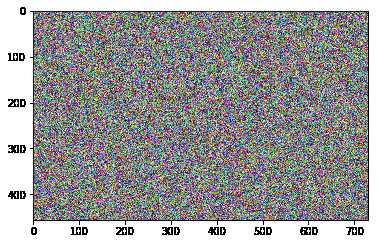
---------------------------------------------------------------------------
ValueError Traceback (most recent call last)
<ipython-input-97-a28aaec0347e> in <module>()
1 plt.imshow(image)
----> 2 plt.show(image)C:\ProgramData\Anaconda3\lib\site-packages\matplotlib\pyplot.py in show(*args, **kw)
251 """
252 global _show
--> 253 return _show(*args, **kw)
254
255 C:\ProgramData\Anaconda3\lib\site-packages\ipykernel\pylab\backend_inline.py in show(close, block)
39 # only call close('all') if any to close
40 # close triggers gc.collect, which can be slow
---> 41 if close and Gcf.get_all_fig_managers():
42 matplotlib.pyplot.close('all')
43 ValueError: The truth value of an array with more than one element is ambiguous. Use a.any() or a.all()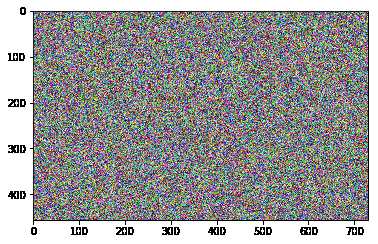
8) np.random.randn(d0, d1, ..., dn)
标准正太分布
n = np.random.randn(10)
narray([-0.4173303 , -0.41736696, -0.11888109, -0.51925789, 1.24985884,
1.52967696, 0.05327912, 0.84738899, 1.03118302, -0.64532473])9)np.random.normal(loc=0.0, scale=1.0, size=None)
n = np.random.normal(175, scale=5.0, size=50)
n array([177.62703208, 176.50746247, 173.26956915, 162.29355083,
172.05271936, 177.61948035, 172.52243162, 175.43294252,
181.14225673, 175.21450574, 179.56055092, 170.883815 ,
170.91435313, 176.25008762, 176.3347509 , 183.90347049,
178.91856559, 168.84725605, 176.32881783, 172.77973728,
173.12257339, 174.75054378, 166.60349541, 171.68263799,
168.83419713, 174.25085091, 175.66113435, 174.12039025,
177.22772738, 169.01523024, 175.57587527, 172.89083838,
179.52153939, 173.70318334, 179.06473552, 176.50099117,
175.83008746, 174.78059027, 175.58909128, 178.11274357,
183.45771692, 172.43399789, 179.56800892, 182.14239994,
176.43701867, 177.37866513, 179.55215095, 174.5389049 ,
175.48698667, 168.73145269])10) np.random.random(size=None)
生成0到1的随机数,左闭右开
n = np.random.random(10)
narray([0.22608606, 0.62764532, 0.62219649, 0.05348086, 0.94994404,
0.29048963, 0.49340728, 0.04651386, 0.59005488, 0.59901244])4个必记参数:
ndim:维度
shape:形状(各维度的长度)
size:总长度
dtype:元素类型
cat.ndim3cat.shape
(456, 730, 3)cat.size998640cat.dtypedtype('uint8')一维与列表完全一致
多维时同理
l = [1,2,3,4,5]
l[2:4][3, 4]n = np.array(l)
n[2]3# 找一个二维ndarray中的某个数
n2 = np.random.randint(0,255, size=(4,4))
n2array([[ 8, 117, 209, 86],
[156, 192, 117, 180],
[ 33, 70, 53, 179],
[ 56, 236, 72, 45]])# 查找53
n2[2][2]53n2[2,2]53n3 = np.random.randint(0,255, size=(4,5,6))
n3array([[[128, 60, 108, 12, 112, 60],
[234, 111, 237, 54, 22, 95],
[127, 226, 30, 181, 20, 85],
[239, 233, 210, 165, 186, 57],
[ 27, 17, 72, 237, 208, 120]],
[[199, 169, 190, 153, 181, 75],
[179, 205, 116, 33, 239, 228],
[154, 204, 138, 5, 231, 97],
[ 55, 193, 245, 105, 78, 210],
[157, 227, 239, 230, 242, 185]],
[[ 67, 232, 113, 189, 245, 206],
[220, 56, 241, 141, 146, 59],
[ 46, 206, 152, 240, 105, 105],
[176, 252, 185, 212, 180, 127],
[165, 130, 206, 77, 11, 56]],
[[194, 82, 72, 80, 94, 237],
[179, 143, 191, 56, 37, 236],
[194, 65, 223, 45, 223, 125],
[ 92, 162, 94, 93, 69, 3],
[ 39, 179, 213, 180, 23, 141]]])n3[1,2,3]5np.random.seed(100)np.random.seed(100)
np.random.randn(10)array([-1.74976547, 0.3426804 , 1.1530358 , -0.25243604, 0.98132079,
0.51421884, 0.22117967, -1.07004333, -0.18949583, 0.25500144])n = np.array([1,2,3,np.nan])
np.sum(n)
np.nansum(n)6.0根据索引修改数据
n3[1,2,3] = 8
n3array([[[128, 60, 108, 12, 112, 60],
[234, 111, 237, 54, 22, 95],
[127, 226, 30, 181, 20, 85],
[239, 233, 210, 165, 186, 57],
[ 27, 17, 72, 237, 208, 120]],
[[199, 169, 190, 153, 181, 75],
[179, 205, 116, 33, 239, 228],
[154, 204, 138, 8, 231, 97],
[ 55, 193, 245, 105, 78, 210],
[157, 227, 239, 230, 242, 185]],
[[ 67, 232, 113, 189, 245, 206],
[220, 56, 241, 141, 146, 59],
[ 46, 206, 152, 240, 105, 105],
[176, 252, 185, 212, 180, 127],
[165, 130, 206, 77, 11, 56]],
[[194, 82, 72, 80, 94, 237],
[179, 143, 191, 56, 37, 236],
[194, 65, 223, 45, 223, 125],
[ 92, 162, 94, 93, 69, 3],
[ 39, 179, 213, 180, 23, 141]]])一维与列表完全一致
多维时同理
l = [1,2,3,4,5]
l[::-1][5, 4, 3, 2, 1]l[::-2]
l[1, 2, 3, 4, 5]将数据反转,例如[1,2,3]---->[3,2,1]
n = np.random.randint(0, 255, size=(4,5))
narray([[211, 112, 94, 165, 6],
[ 86, 15, 241, 38, 139],
[185, 247, 99, 91, 31],
[221, 33, 40, 137, 162]])两个::进行切片
n[::-1]
narray([[211, 112, 94, 165, 6],
[ 86, 15, 241, 38, 139],
[185, 247, 99, 91, 31],
[221, 33, 40, 137, 162]])使用reshape函数,注意参数是一个tuple!
n = np.arange(6)
n
array([0, 1, 2, 3, 4, 5])n2 = np.reshape(n,(3,2))
n2array([[0, 1],
[2, 3],
[4, 5]])cat.shape(456, 730, 3)n = np.reshape(cat, (8322, 120))
narray([[231, 186, 131, ..., 235, 190, 135],
[237, 192, 137, ..., 237, 192, 137],
[237, 192, 137, ..., 239, 192, 138],
...,
[203, 125, 89, ..., 201, 121, 86],
[200, 120, 85, ..., 197, 117, 82],
[197, 117, 82, ..., 188, 95, 62]], dtype=uint8)n1 = np.random.randint(0,255, size=(5,6))
n2 = np.random.randint(0,255, size=(5,6))
display(n1,n2)array([[ 67, 115, 248, 66, 212, 248],
[ 66, 156, 231, 250, 39, 195],
[248, 172, 19, 21, 200, 206],
[139, 25, 3, 18, 3, 49],
[ 55, 21, 12, 6, 218, 116]])array([[182, 251, 137, 33, 60, 6],
[169, 117, 245, 218, 96, 168],
[231, 59, 117, 179, 76, 84],
[ 6, 24, 25, 51, 136, 89],
[ 67, 156, 135, 101, 147, 90]])np.concatenate((n1,n2),axis=1)array([[ 67, 115, 248, 66, 212, 248, 182, 251, 137, 33, 60, 6],
[ 66, 156, 231, 250, 39, 195, 169, 117, 245, 218, 96, 168],
[248, 172, 19, 21, 200, 206, 231, 59, 117, 179, 76, 84],
[139, 25, 3, 18, 3, 49, 6, 24, 25, 51, 136, 89],
[ 55, 21, 12, 6, 218, 116, 67, 156, 135, 101, 147, 90]])# hstack h
new_image = np.hstack((cat, image))
plt.imshow(new_image)
plt.show()

# vstack vertical
new_image = np.vstack((cat, image))
plt.imshow(new_image)
plt.show()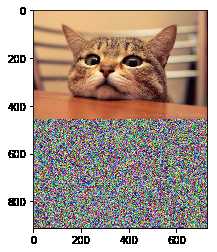
与级联类似,三个函数完成切分工作:
n = np.random.randint(0,100,size = (4,6))
narray([[92, 7, 55, 5, 20, 53],
[42, 61, 91, 64, 95, 18],
[25, 93, 48, 35, 39, 13],
[42, 97, 73, 57, 14, 59]])np.vsplit(n,(1,2))[array([[92, 7, 55, 5, 20, 53]]),
array([[42, 61, 91, 64, 95, 18]]),
array([[25, 93, 48, 35, 39, 13],
[42, 97, 73, 57, 14, 59]])]n = np.random.randint(0,100, size=(6,6))
narray([[48, 77, 69, 24, 83, 20],
[80, 92, 21, 97, 16, 37],
[52, 99, 2, 33, 28, 3],
[ 5, 53, 34, 3, 0, 95],
[27, 73, 95, 85, 8, 48],
[30, 54, 49, 75, 44, 90]])np.vsplit(n, (2,5))[array([[48, 77, 69, 24, 83, 20],
[80, 92, 21, 97, 16, 37]]), array([[52, 99, 2, 33, 28, 3],
[ 5, 53, 34, 3, 0, 95],
[27, 73, 95, 85, 8, 48]]), array([[30, 54, 49, 75, 44, 90]])]np.split(n, 3, axis=1)[array([[48, 77],
[80, 92],
[52, 99],
[ 5, 53],
[27, 73],
[30, 54]]), array([[69, 24],
[21, 97],
[ 2, 33],
[34, 3],
[95, 85],
[49, 75]]), array([[83, 20],
[16, 37],
[28, 3],
[ 0, 95],
[ 8, 48],
[44, 90]])]np.vsplit(n, 3)[array([[48, 77, 69, 24, 83, 20],
[80, 92, 21, 97, 16, 37]]), array([[52, 99, 2, 33, 28, 3],
[ 5, 53, 34, 3, 0, 95]]), array([[27, 73, 95, 85, 8, 48],
[30, 54, 49, 75, 44, 90]])]np.hsplit(n, 3)[array([[48, 77],
[80, 92],
[52, 99],
[ 5, 53],
[27, 73],
[30, 54]]), array([[69, 24],
[21, 97],
[ 2, 33],
[34, 3],
[95, 85],
[49, 75]]), array([[83, 20],
[16, 37],
[28, 3],
[ 0, 95],
[ 8, 48],
[44, 90]])]np.hsplit(n,(2,4))[array([[33, 46],
[98, 40],
[47, 53],
[34, 91]]), array([[53, 7],
[12, 55],
[69, 50],
[32, 52]]), array([[56, 43],
[18, 64],
[69, 7],
[83, 38]])]cat.shape(456, 730, 3)456
730result = np.split(cat, 2, axis = 0)plt.imshow(result[0])
plt.show()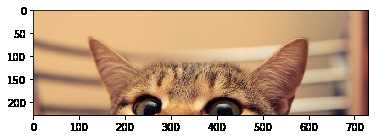
s_result = np.split(cat,2,axis = 1)len(s_result)2plt.imshow(s_result[0])
plt.show()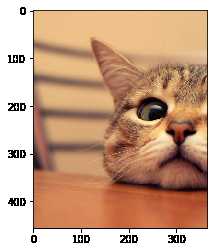
所有赋值运算不会为ndarray的任何元素创建副本。对赋值后的对象的操作也对原来的对象生效。
l = [1,2,3,4]
l2 = l
l2[2] = 5
l[1, 2, 5, 4]n1 = np.arange(10)
n2 = n1
n2[3] = 100
n1array([ 0, 1, 2, 100, 4, 5, 6, 7, 8, 9])n3 = n1.copy()
n3[5] = 200
n1array([ 0, 1, 2, 100, 4, 5, 6, 7, 8, 9])可使用copy()函数创建副本
n = np.arange(11)
narray([ 0, 1, 2, 3, 4, 5, 6, 7, 8, 9, 10])np.sum(n)55n = np.random.randint(0,100, size=(5,6))
narray([[80, 20, 30, 66, 48, 50],
[52, 33, 3, 76, 35, 9],
[70, 99, 69, 50, 44, 31],
[40, 13, 52, 50, 33, 45],
[69, 42, 55, 30, 61, 22]])np.sum(n, axis=1)array([294, 208, 363, 233, 279])同理
n = np.arange(11)
narray([ 0, 1, 2, 3, 4, 5, 6, 7, 8, 9, 10])np.median(n)5.0np.mean(n)5.0n = np.random.randint(0,100,size=10)
narray([42, 64, 40, 7, 0, 79, 32, 95, 95, 59])np.mean(n)51.3np.median(n)50.5np.max(n)10np.min(n)0n = np.random.randint(0,100, size=(5,6))
narray([[82, 44, 0, 33, 72, 99],
[66, 25, 36, 88, 74, 78],
[ 3, 53, 33, 76, 96, 69],
[62, 10, 16, 22, 12, 31],
[41, 57, 43, 79, 34, 7]])np.max(n, axis=0)array([82, 57, 43, 88, 96, 99])Function Name NaN-safe Version Description
np.sum np.nansum Compute sum of elements
np.prod np.nanprod Compute product of elements
np.mean np.nanmean Compute mean of elements
np.std np.nanstd Compute standard deviation
np.var np.nanvar Compute variance
np.min np.nanmin Find minimum value
np.max np.nanmax Find maximum value
np.argmin np.nanargmin Find index of minimum value
np.argmax np.nanargmax Find index of maximum value
np.median np.nanmedian Compute median of elements
np.percentile np.nanpercentile Compute rank-based statistics of elements
np.any N/A Evaluate whether any elements are true
np.all N/A Evaluate whether all elements are true
np.power 幂运算np.argmin(n, axis=0)array([2, 3, 0, 3, 3, 4], dtype=int64)cat.shape(456, 730, 3)cat2 = cat.reshape((-1,3))
cat2.shape(332880, 3)n = np.random.randint(0,10, size=(4,5))
narray([[8, 8, 9, 1, 5],
[7, 9, 9, 5, 9],
[4, 1, 0, 0, 1],
[6, 5, 4, 2, 9]])np.reshape(n,(-1,))array([8, 8, 9, 1, 5, 7, 9, 9, 5, 9, 4, 1, 0, 0, 1, 6, 5, 4, 2, 9])cat3 = cat.reshape((456*730,3))
cat3.shape(332880, 3)cat3.max(axis = 0)array([255, 242, 219], dtype=uint8)max_cat = cat.max(axis = (0,1))
max_cat
array([255, 242, 219], dtype=uint8)
max_cat.shape
(3,)
cat.min()
0
np.sum 和 np.nansum 的区别
nan not a number
a = np.array([1,2,np.nan])
a
array([ 1., 2., nan])
np.nansum(a)
3.0
使用pandas打开文件president_heights.csv
获取文件中的数据
import pandas as pd
data = pd.read_csv('president_heights.csv')
type(data)
data
| order | name | height(cm) | |
|---|---|---|---|
| 0 | 1 | George Washington | 189 |
| 1 | 2 | John Adams | 170 |
| 2 | 3 | Thomas Jefferson | 189 |
| 3 | 4 | James Madison | 163 |
| 4 | 5 | James Monroe | 183 |
| 5 | 6 | John Quincy Adams | 171 |
| 6 | 7 | Andrew Jackson | 185 |
| 7 | 8 | Martin Van Buren | 168 |
| 8 | 9 | William Henry Harrison | 173 |
| 9 | 10 | John Tyler | 183 |
| 10 | 11 | James K. Polk | 173 |
| 11 | 12 | Zachary Taylor | 173 |
| 12 | 13 | Millard Fillmore | 175 |
| 13 | 14 | Franklin Pierce | 178 |
| 14 | 15 | James Buchanan | 183 |
| 15 | 16 | Abraham Lincoln | 193 |
| 16 | 17 | Andrew Johnson | 178 |
| 17 | 18 | Ulysses S. Grant | 173 |
| 18 | 19 | Rutherford B. Hayes | 174 |
| 19 | 20 | James A. Garfield | 183 |
| 20 | 21 | Chester A. Arthur | 183 |
| 21 | 23 | Benjamin Harrison | 168 |
| 22 | 25 | William McKinley | 170 |
| 23 | 26 | Theodore Roosevelt | 178 |
| 24 | 27 | William Howard Taft | 182 |
| 25 | 28 | Woodrow Wilson | 180 |
| 26 | 29 | Warren G. Harding | 183 |
| 27 | 30 | Calvin Coolidge | 178 |
| 28 | 31 | Herbert Hoover | 182 |
| 29 | 32 | Franklin D. Roosevelt | 188 |
| 30 | 33 | Harry S. Truman | 175 |
| 31 | 34 | Dwight D. Eisenhower | 179 |
| 32 | 35 | John F. Kennedy | 183 |
| 33 | 36 | Lyndon B. Johnson | 193 |
| 34 | 37 | Richard Nixon | 182 |
| 35 | 38 | Gerald Ford | 183 |
| 36 | 39 | Jimmy Carter | 177 |
| 37 | 40 | Ronald Reagan | 185 |
| 38 | 41 | George H. W. Bush | 188 |
| 39 | 42 | Bill Clinton | 188 |
| 40 | 43 | George W. Bush | 182 |
| 41 | 44 | Barack Obama | 185 |
heights = data['height(cm)']
heights
type(heights)
pandas.core.series.Series
np.max(heights)
193
np.mean(heights)
179.73809523809524
np.std(heights)
6.931843442745893
np.min(heights)
163
1) 算术运算符:
n = np.random.randint(0,10, size=(4,5))
n
array([[2, 5, 0, 4, 6],
[0, 0, 7, 5, 0],
[6, 3, 2, 9, 2],
[5, 7, 0, 4, 5]])
# 加
n + 1
array([[ 3, 6, 1, 5, 7],
[ 1, 1, 8, 6, 1],
[ 7, 4, 3, 10, 3],
[ 6, 8, 1, 5, 6]])
# 减
n - 1
array([[ 1, 4, -1, 3, 5],
[-1, -1, 6, 4, -1],
[ 5, 2, 1, 8, 1],
[ 4, 6, -1, 3, 4]])
# 两个矩阵相加
n2 = np.random.randint(0,10,size=(4,5))
n2
array([[2, 4, 2, 5, 9],
[6, 6, 9, 6, 2],
[9, 7, 5, 6, 1],
[4, 6, 7, 2, 9]])
n + n2
array([[ 4, 9, 2, 9, 15],
[ 6, 6, 16, 11, 2],
[15, 10, 7, 15, 3],
[ 9, 13, 7, 6, 14]])
n3 = np.random.randint(0,10,size=(2,5))
n3
array([[8, 0, 0, 5, 8],
[4, 0, 3, 6, 7]])
n2 + n3
---------------------------------------------------------------------------
ValueError Traceback (most recent call last)
<ipython-input-97-5f0861827bc6> in <module>()
----> 1 n2 + n3
ValueError: operands could not be broadcast together with shapes (4,5) (2,5)
2) 矩阵积np.dot()
n1 = np.random.randint(0,10,size=(2,3))
n1
array([[8, 9, 4],
[1, 7, 5]])
n2 = np.random.randint(0,10, size=(3,4))
n2
array([[4, 4, 2, 7],
[4, 4, 7, 3],
[1, 3, 2, 7]])
np.dot(n1,n2)
array([[ 72, 80, 87, 111],
[ 37, 47, 61, 63]])
【重要】ndarray广播机制的两条规则
例1:
m = np.ones((2, 3))
a = np.arange(3)
求M+a
m = np.ones((2,3),dtype=int)
m
array([[1, 1, 1],
[1, 1, 1]])
n = np.arange(3)
n
array([0, 1, 2])
m + n
array([[1, 2, 3],
[1, 2, 3]])
例2:
a = np.arange(3).reshape((3, 1))
b = np.arange(3)
求a+b
a = np.arange(3).reshape((3,1))
a
array([[0],
[1],
[2]])
b = np.arange(3)
b
array([0, 1, 2])
a + b
array([[0, 1, 2],
[1, 2, 3],
[2, 3, 4]])
习题
a = np.ones((4, 1))
b = np.arange(4)
求a+b
小测验:
使用以上所学numpy的知识,对一个ndarray对象进行选择排序。
def Sortn(x):
代码越短越好
n = [5,2,3,6,9]
def bubble(n):
for i in range(len(n) -1):
for j in range(i+1, len(n)):
if n[i] > n[j]:
n[i], n[j] = n[j], n[i]
bubble(n)
n
[2, 3, 5, 6, 9]
# 选择排序
def select(n):
for i in range(len(n)):
# 选出最小值的索引
index = np.argmin(n[i:]) + i
# 把最小值和当前值的位置换一下
n[i], n[index] = n[index], n[i]
n = [4, 6,1,0,3]
select(n)
n
[0, 1, 3, 4, 6]
np.sort()与ndarray.sort()都可以,但有区别:
n = np.random.randint(0,10,size=6)
n
array([6, 7, 1, 1, 8, 3])
np.sort(n)
array([1, 1, 3, 6, 7, 8])
np.sort(n)
n
array([6, 7, 1, 1, 8, 3])
n.sort()
n
array([1, 1, 3, 6, 7, 8])
标签:man 基本 tee inline lock package lua geo nal
原文地址:https://www.cnblogs.com/pankypan/p/11408738.html